
How to Write a Product Spec Sheet [Including Templates]
![How to Write a Product Spec Sheet [Including Templates]](https://visme.co/blog/wp-content/uploads/2023/12/How-to-Effectively-Create-a-Product-Spec-Sheet-Header.jpg)
![How to Write a Product Spec Sheet [Including Templates]](https://visme.co/blog/wp-content/uploads/2023/12/How-to-Effectively-Create-a-Product-Spec-Sheet-Header.jpg)
Whether you're introducing a new product to your team or educating your customers, a clear and compelling product spec sheet can serve as your guiding map for success. It outlines what you’re set to develop and the requirements and functions the product is expected to fulfill.
A well-prepared spec sheet supports various aspects of a product's lifecycle, from development and marketing to sales and post-sales support.
If you’re a newbie in product management or looking to improve your spec sheet, you’re in the right place. In this article, we'll provide practical insights on creating a product spec effectively. We'll also offer customizable templates to jumpstart your planning journey.
A spec sheet, also known as a specification sheet, is a business one pager document that provides a list of a product’s features and characteristics. It articulates the product's features, specifications, and details—the what, how, and why behind the production and sales.
Project managers create spec sheets and even data sheets to ensure consistency and accuracy in product development, manufacturing, and quality control. It helps shareholders make informed decisions, maintain quality standards, and facilitate effective communication throughout the product development and production process.
Specification sheets can be used in various industries, such as manufacturing, engineering, construction, and electronics. They are different from fact sheets and sell sheets, which are primarily used for marketing purposes and highlight key features and benefits instead of focusing on a product’s technical specifications.
Here are some of the key reasons why spec sheets are important:
Spec sheets can ensure a shared understanding of your product specifications and requirements. This helps to reduce the likelihood of misunderstandings or misinterpretations. By providing accurate information, customers are clear on what your product offers and what they are getting.
Quality assurance teams use spec sheets as a reference point for quality control checks. They compare the actual product against the specifications to identify deviations or defects. This will help you maintain consistent quality and performance by setting specific standards and criteria your product must meet.
They guide the design and development process by detailing materials, dimensions, and features, enabling product designers to work from a common reference point. However, for construction or engineering projects, spec sheets help project managers coordinate tasks, become more agile, ensure quality control, and track progress.
In consumer markets, you can use spec sheets to highlight unique features and advantages of your product, helping it stand out from competitors. Providing spec sheets to customers helps them make informed purchasing decisions by detailing product specifications and benefits.
Also, a well-crafted spec sheet can reflect a brand's commitment to quality, innovation, and transparency. The level of detailed information presented can help establish and reinforce the brand's identity and values in the minds of customers and industry peers.
Spec sheets provide detailed information about products, thus enabling efficient communication between the procurement team, suppliers, and other shareholders.
This helps to streamline the procurement process, reduce errors and save time by specifying the materials, components, and quantities needed. It also makes it easier for companies to source and purchase items for production.
Spec sheets are a benchmark for ongoing product improvement and innovation, as manufacturers can use them as reference points for updates and enhancements.
More so, they provide a reference point for documentation throughout a product's lifecycle.
For example, as you use equipment over time, it may require maintenance or repairs. Documentation created during the design phase or updated throughout the product's life becomes invaluable here. It can guide technicians or users in understanding the product's components, how they work and how they can be fixed or maintained.
The content and format of a product specification sheet can vary depending on the industry, product and its intended audience.
However, a standard spec sheet, irrespective of the product, should have some important elements.
Here are what you can include when creating your own:
In the real sense, creating a spec sheet can be tasking. Visme offers ready-to-use, customizable, and professional templates that perfectly fit your product requirements.
The Visme editor also offers another document creation solution for your spec sheets. The AI Document Generator saves time by helping you create a quick first draft of any document.
In the prompt, input all the features you want the spec sheet to have, plus any relevant content information. Choose one of the styles the chatbot offers and let the AI do its magic.
If you’re ready to get started with a template, here are 8 ready-made designs you can use for yourself:
Here are 8 ready-made templates you can use for yourself:
Utilize this one-slide product specification template to articulate your product’s unique value proposition and distinguish it from competitors. The template provides information in a simple way.
You can easily customize each section to match your product specifications. This ensures users get a well-rounded view of what your product offers and how it benefits them.
Leverage interactive features such as clickable pop-ups or hover effects to provide additional information about your products. This will not only offer your readers an engaging experience but also ensure you don't stuff too much text on a one-pager.
Use this template to communicate your vehicle's specifications and features to both the internal team and external stakeholders. It can also serve as a comprehensive guide because it details every aspect of the vehicle's design and functionality.
The visually appealing combination of black and pink hues on a white background is arranged to capture anyone's interest at first sight.
This design specification sheet template is entirely customizable; you can customize the text, font, and color to match your design style.
For a seamless integration with your brand, you can utilize Visme’s brand wizard tool. Simply input your website's address and they will retrieve your website's logo, brand colors, and fonts. Your brand assets will be stored and can be used for any content you create on Visme.
Utilize this minimalistic spec sheet template to introduce your software product to the world. The template elegantly incorporates a combination of various blue tones. It includes sections such as introduction, scope, and more on both pages.
This template is divided into clear sections such as Introduction, Scope, Functional Requirements, and Non-Functional Requirements, making it easier to organize and communicate complex software needs.
You can also include details about the user interface or user personas to provide better context and improve usability.
This clear description ensures that all shareholders have a shared understanding of the project’s objectives and requirements.
You can make the sheet interactive by linking to other projects, external websites or content blocks to items on your canvas.
Create a quality reference guide for stakeholders involved in the production, distribution, or evaluation of your product with this spec sheet template. This will help to keep accuracy in check during the whole production and testing process.
This equipment specification sheet includes a description, information, specifications and technical requirements, acceptance criteria, testing methods, metrics and reporting and documentation sections. You can customize these sections with your specific information like safety standards (if any), branding, and visual elements.
You can invite department heads or other team representatives to provide input using Visme’s collaboration tool. Team members can edit the design, give remarks and tag each other in real-time, aiding efficiency. The workflow management tool also allows you to delegate tasks to team members, approve designs, and set deadlines.
Present your technical details or project effortlessly using this simple, vibrant, and bright standard sheet template. Your development team will easily grasp project details with clarity, as this template eliminates superfluous information, focusing on essential aspects like construction methods, testing, quality assurance, and more.
This template is designed with a clean and professional layout. The use of color blocks for section headers enhances readability, while consistent typography ensures the information is easy to digest. The branding is subtle yet present, maintaining corporate identity without overshadowing the content's importance.
With Visme's various sharing and downloading options, the possibilities for utilizing this unique template design are endless. Share it online through a public or private link, or embed it on your website. The template is also available for download in JPG, PNG, and PDF formats.
For high-quality printing results and to preserve quality once the product specification sheet is downloaded, opt for the PDF format with bleed marks.
Outline the material quality of your product with this material spec sheet template. It helps you present your product's distinctive qualities to entice your customers to buy. Armed with this sheet, your clients can make informed decisions about material selection and utilization.
You can use this template to create spec sheets for any final product or material you want to sell. You can edit the table elements with your product properties. It has a compelling appearance of a neutral color scheme with a light background and darker text, which allows for high readability and a sleek look.
Additionally, you can create a safety data sheet template to complement your material specification one-pager, ensuring that a distributor or contractor purchasing your product has all the legal and necessary details they need.
Select high-resolution images from the Visme library to make your design appealing. If you have difficulty finding one, use our AI image generator to create images that best suit your needs. You can generate various paintings, pencil drawings, 3D graphics, icons, abstract art, and more using this feature.
Visme’s shortcut tool makes it seamless to locate any feature or design element you’re looking for in the editor. Simply use the slash (/) key to initiate a search and type your query into the search bar and you’ll find your desired feature or element.
This template offers a structured and visually appealing roadmap to present technical information to your audience.
Use this template to convey information efficiently and attractively, enhancing the readability and professionalism of the document. A clear format can lead to better customer understanding and satisfaction, as they can easily find the information they're looking for.
This infographic specification sheet template gives room for a more detailed explanation of your product features. It uses both visual and written content to represent what the product stands for.
You can use it perfectly for a project guide or a step-by-step how-to use a product.
Leverage our data visualization tools, such as tables, charts, maps, or graphs, to showcase data or explain concepts about your product in a concise and easy-to-understand format.
Want to run an extensive product test or product development process? This spec sheet example design gives all the requirements for an effective product test.
Utilize the template’s section to give a detailed insight into your product test information such as test objectives, scope of testing, testing methods, test environment, test cases and lots more.
You can change this template in its entirety. To customize this template, edit it with your favorite Visme design elements or upload your own unique fonts, logos, and color themes.
Use Visme’s analytic feature to track the level of engagement on your product specification sheet. This can serve as a pointer to know if your team members are actively engaging with your sheet and if it’s valuable to your audience.
Pro Tip: If at any point you’re having trouble condensing your product’s information so it all fits in the spec sheet layout, try the Visme AI Writer. In the prompt window, ask it to summarize or minimalize a piece of text without it losing meaning. Likewise, get help writing descriptive sentences that are short and to the point.
Writing a product specification sheet doesn't need to be complicated. Follow the tips below to write a product spec sheet that ticks all the boxes:
Follow these steps to create your specification sheet with Visme.
Sign in to your Visme account to begin. It is simple to set up if you do not already have one. Just sign up on Visme's website.
Once you're logged in, select a suitable template to start your spec sheet. You can search for "spec sheet" and browse through specific categories that are relevant to your business.
Customize the template to match your needs. You can change colors, fonts, add your logo, and replace any placeholder text or images with your own content.

Pay attention to formatting and styling to make your spec sheet visually appealing and easy to read. Use consistent fonts, colors, and spacing.
Spec sheets often consist of various sections, such as product details, technical specifications, features, and images. Create and label these sections within your template.
Fill in the details for each section. This might include product names, descriptions, images, part numbers, dimensions, materials, pricing, and any other important information.
Feel free to change the fonts, text and background color of your spec sheets. Then, insert images or graphics that illustrate the product or service.

You can pick suitable visuals from Visme's library of high-resolution stock photos, icons and illustrations. Visme offers a wide range of icons and illustrations that can help convey information more effectively. You can use these to represent features, benefits, or any other relevant data.
If you do not find an image that suits you in the library collections, the Visme AI image generator is your go-to! This text-to-image generator will give you tons of AI-generated images that are perfect for your use. All you have to do is give a prompt and in a twinkling of an eye, the wizard does its wonder.
Review and proofread your specification sheet to ensure accuracy and clarity. Once you're satisfied with it, you can share and download it. You can export it in various formats, such as PDF, image, or interactive HTML. Depending on your needs, you can either share the spec sheet online via a link or print it for physical distribution.

Here’s a look at some of the top tools for creating product specification sheets, along with a detailed comparison to help you find the right fit for your needs.
| Tools | Features | Pricing | Ratings |
| Visme | Extensive library of professionally designed product spec sheet templates, Brand Wizard, Real-time collaboration, project management tools, Millions of design assets, 30+ types of visualizations, Access control and password protection, Built-in Analytics AI-powered tools | Free, Paid plans from 12.25/month |
G2: 4.5/5, Capterra: 4.5/5 |
| Canva | Templates, Magic Resize for multi-format design, Wide range of design assets, Video embeds from YouTube, Vimeo, and personal uploads, Real-time collaboration with comment tracking, AI-powered tools | Free, Paid plans start from $10/month |
G2: 4.7/5 , Capterra: 4.7/5 |
| Confluence | Real-time collaboration tools, Interconnected content with linked pages, Built-in version control with edit history and restore options, Smart search functionality for quick document discovery, Interactive structuring with macros | Free, Paid plans start from $5.16/user/month |
G2: 4.5/5, Capterra: 4.5/5 |
| Notion | Extensive library of professionally designed templates, Brand Wizard, Real-time collaboration, project management tools, Millions of design assets, 30+ types of visualizations, Access control and password protection, Built-in Analytics AI-powered tools | Free, Paid plans start at $10/seat/month |
G2: 4.5/5, Capterra: 4.7/5 |
| ClickUp | Custom fields for capturing product-specific data, Centralized access with file, image, and document attachments, Real-time collaboration tools, Organized structure with Workspaces, Folders, Lists, and Tasks, automation features | Free, Paid plans start at $7/user/month |
G2: 4.7/5, Capterra: 4.6/5 |
Visme is a powerful all-in-one design tool with an extensive range of features for creating professionally designed product-spec sheets and other business assets.
As a non-designer, I found Visme’s interface to be very user-friendly. Its sleek, drag-and-drop interface is incredibly intuitive even if you've never used a design tool before.

For this review, I wanted to create my product spec sheet quickly; I simply selected a sleek template, dragged it onto the canvas, and plugged in my product details. In under 10 minutes, I had a professional-looking spec sheet that looked like it came from a design agency.

Visme also comes packed with a massive library of visuals ranging from high-quality photos and videos to modern icons, 3D elements and animated illustrations. You can easily switch up the product image in your spec sheet with an option from the library or even use the AI image generator to create a new image that suits your needs.
I tried to change the image in this template from a laptop to a wearable neurotech gadget using the AI image generator and here’s what I got.
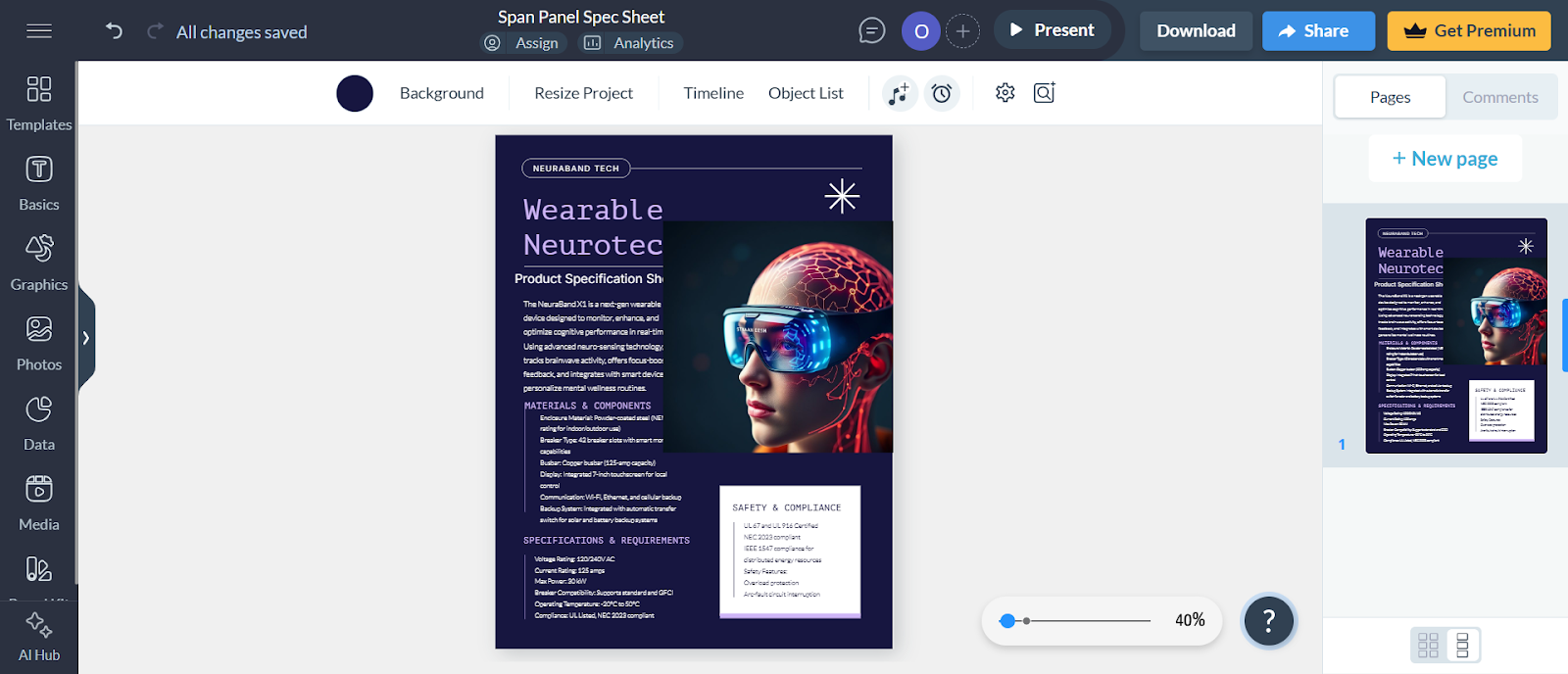
Visme also takes things up a notch when it comes to interactive features. You can embed a short demo video into the sheet so that buyers can watch the product in action directly on the spec sheet, without needing to visit another page. You can also convert your product spec sheet into an interactive presentation for retailers who want more details.
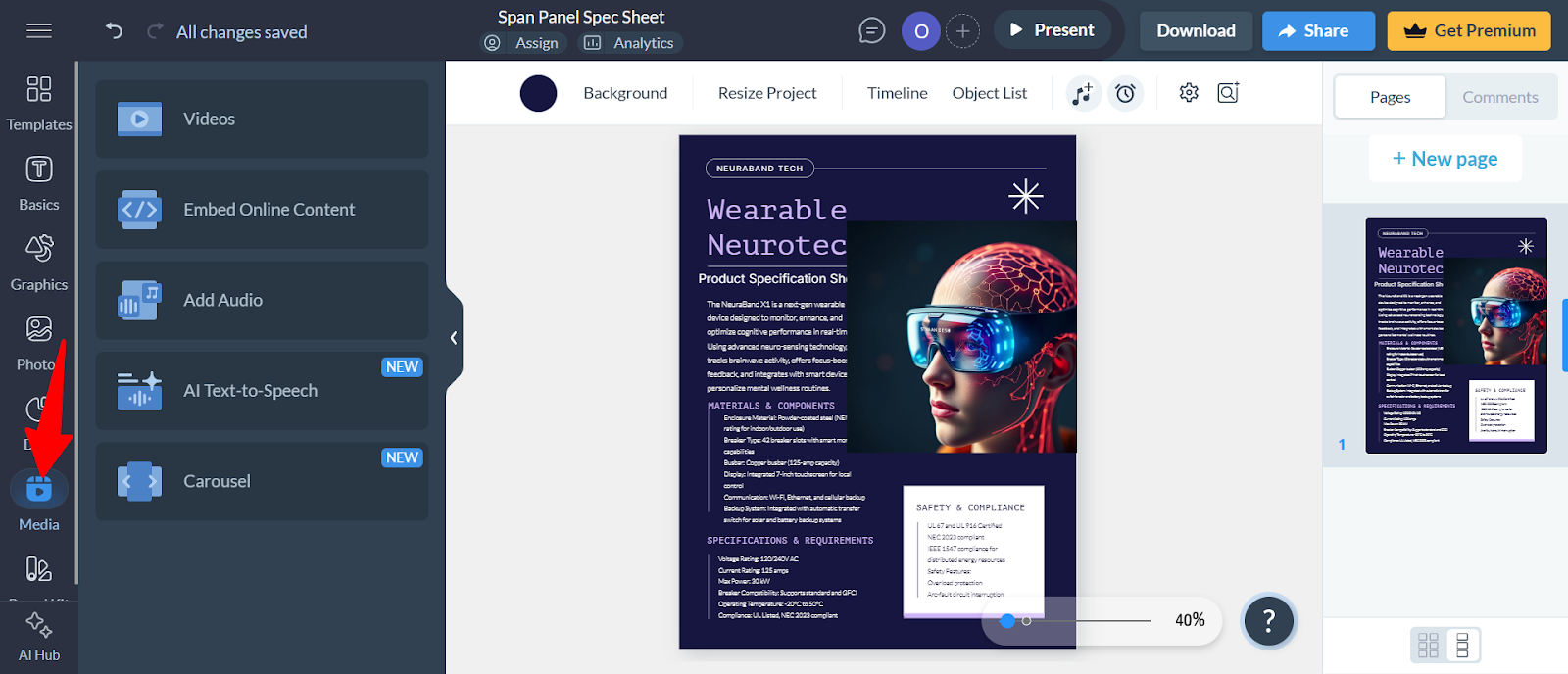
But that’s not all. You can include clickable links to technical documents, 3D models, or product manuals, and even add animated product illustrations or transitions to guide the viewer through each section. Need to make your spec sheet portable? Add a QR code that links to a live online version or a prototype.
Visme’s resize feature also comes in handy if you want to change your spec sheet’s size to fit a particular use case whether that is for a presentation, a PDF document or social media graphic.
If you want to present your spec sheet to shareholders or clients, it's easy to do so directly from the Visme dashboard. Simply click on the Present icon and it’ll move your design to a presentation mode.
Note: Visme offers discounted pricing plans for students, educators and nonprofits.
Canva is another popular design tool that’s known for its simplicity and user-friendliness.
There are dozens of templates in Canva’s library that are easy to customize. Although the templates are primarily eCommerce product specs, so if you’re looking for designs tailored to a corporate audience, you might not find the best fit.

I started out with one of Canva’s templates and it was quite easy to customize.
You can manually add colors and fonts to match your brand style, or use the integrated Brand Kit to automatically apply your brand assets across designs.
I was quite impressed by how the AI Magic tool recommends images that might fit into your spec sheet.
The mock-up Studio feature is another cool feature that can help you create realistic mockups using your product designs. It’s a great way to add professional and eye-catching product images to your specification sheets.
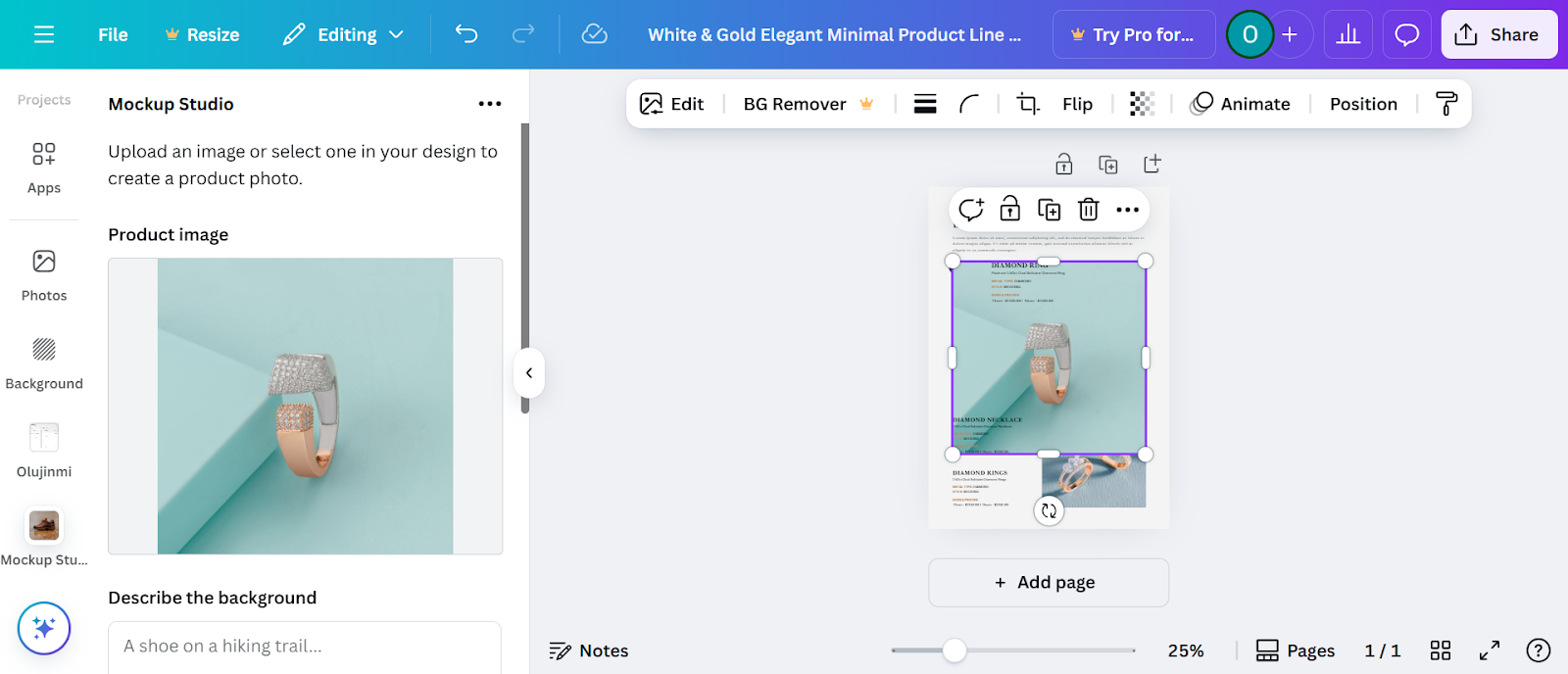
Like Visme, Canva also offers Resize and Magic Switch tools which help you adapt your spec sheet for different platforms or switch up the layout.
Confluence is a powerful documentation tool built by Atlassian. While the editor isn’t design-heavy like Canva or Visme, the knowledge management and team collaboration features make it a great tool for creating product spec sheets.
Confluence’s interface is very simple and it gives a clear, comprehensive view of what you’re working on and what other people are working on.
I couldn't find any product spec template in the library so I had to start designing from scratch, which can be intimidating, especially if you’ve never created a product spec sheet before.
Here’s what I could come up with:

You can link to technical specs, design files or user stories. You can even embed product images and videos to which is especially helpful for showcasing features in action.
Beyond that, one of Confluence’s features that caught my interest is the Macros feature. They are designed to enhance the functionality of pages and make them more interactive. You’ll find macros such as Code Snippet, Decisions, Expand, Status and more.
For instance, the Status feature is a handy way to track the progress of your product spec sheet. It’s especially helpful when different sections require input or approval from shareholders.
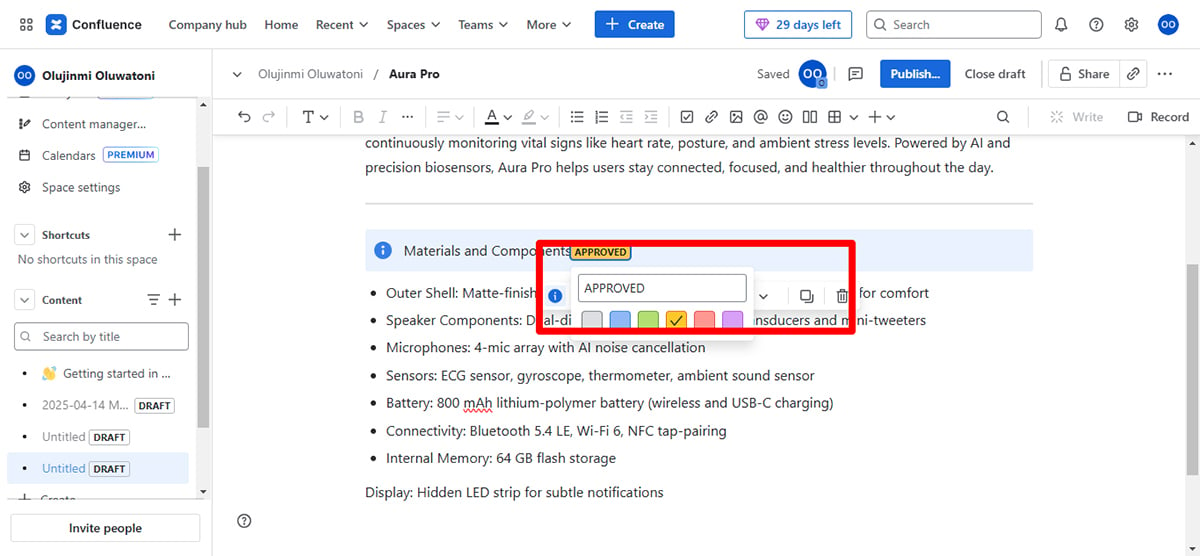
Overall, Confluence works well if your focus is more on practicality and collaboration rather than visual design. But if your aim is to create a specification sheet that’s design-heavy or highly polished, it may fall short due to its limited design assets and styling options.
Next up on my list is Notion. If you like your documentation organized and easy to collaborate on, this tool brings some serious flexibility to the table.
Notion is primarily a note-taking and data management application with collaborative features and extensive customizability.
The Notion Marketplace has several product specification templates and it is really easy to tailor them to your process. You can drag in toggles, callouts, tables, timelines, and embed YouTube or Loom videos.
I chose the template provided by Notion:
It’s visually plain compared to Visme’s product spec template but it can be useful if you need something that just works.
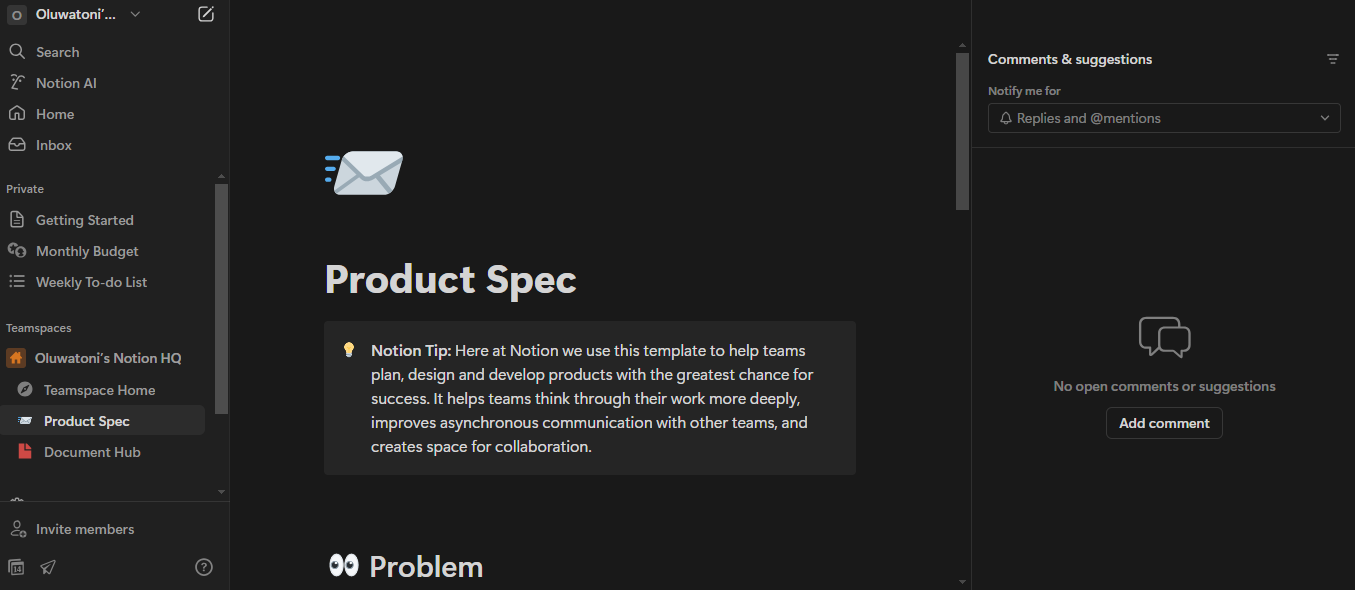
Notion is built for structured content. You can add new blocks for other details for the project. You can also structure your content in a way that makes sense for you, with the ability to create hierarchical pages, nested databases, and link different pieces of information together.
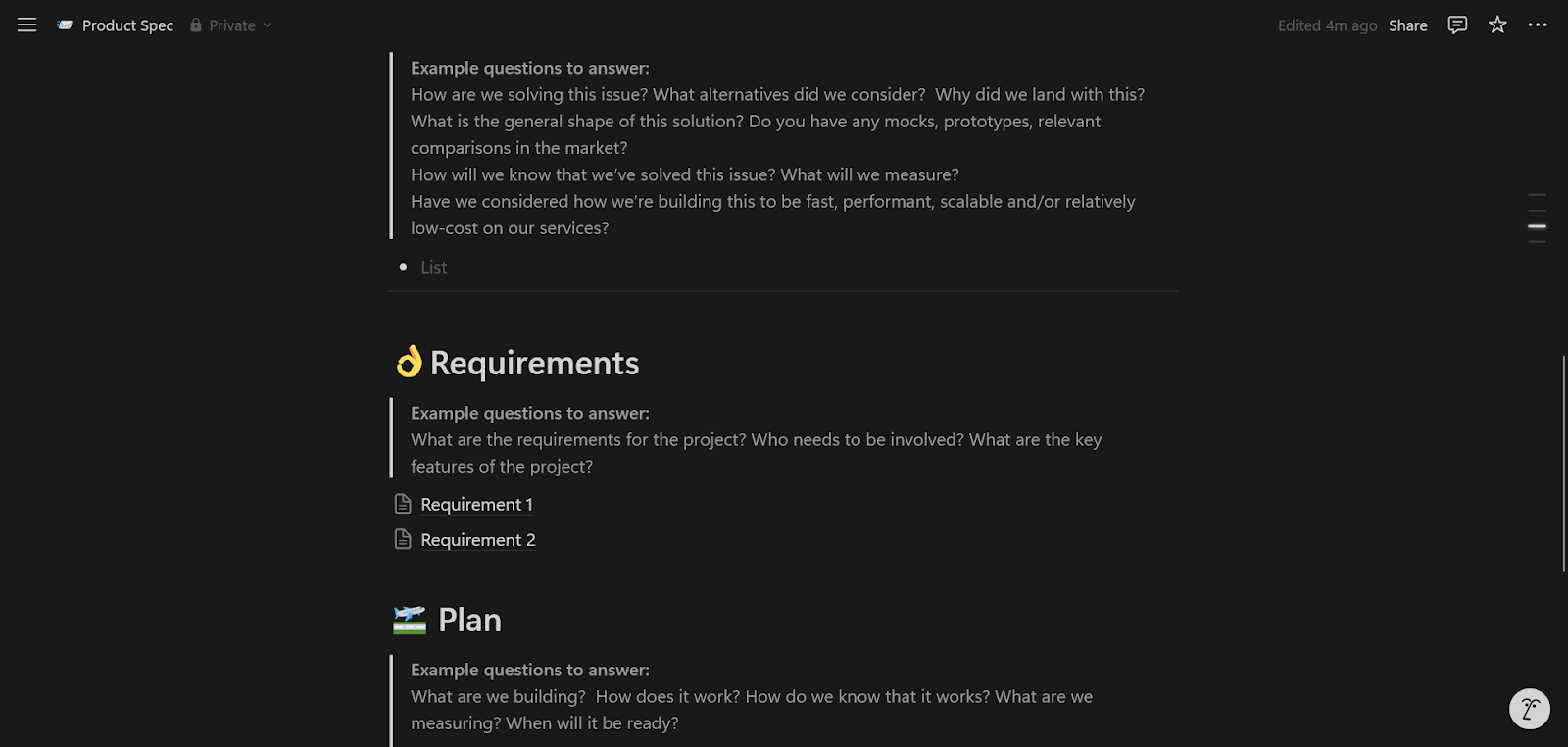
On the collaborative front, Notion does a pretty good job. It features comments, mentions, task assignments, and synced updates which make it very easy to work across departments when creating your spec sheet.
However, like some other project management and documentation tools on this list, Notion doesn't come with advanced design assets or interactive tools that can help you create visually appealing spec sheets.
ClickUp is a productivity platform built to centralize everything from task management, collaboration to documentation.
The interface feels very clean and modern. However, ClickUp has quite a long learning curve because of its extensive features. In my opinion, the features are quite extensive but appear to be more geared towards task management than creating documents.
ClickUp does provide several product specification templates and you can customize any of them for free.
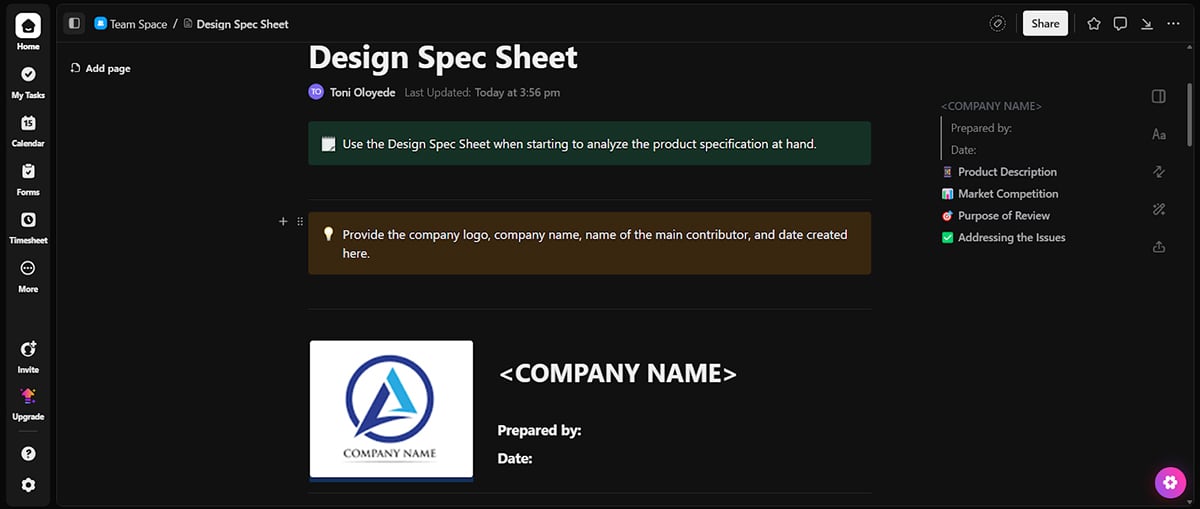
There are options to add headings, tables, comments, and embed media, as well as link to pages and documents.
Another aspect ClickUp really shines is that you can create tasks from the document. You can link tasks to each section, assign owners, and even embed timelines or dependencies for related deliverables. This makes it very easy to manage the whole process of creating the spec sheet.
Another plus is that, once your spec sheet is complete, you can easily connect it to automated systems, like notifying relevant teams or updating packaging briefs.
However, you should note that ClickUp isn’t built for design, so it won’t offer the same level of visual flexibility as design tools like Visme or Canva. But if your goal is to streamline projects and keep your product specs tightly integrated with your project management process, it works well.
In the words of a Reddit user, “The hierarchy ability sets it apart for us. It handles all the chaos outside of our enterprise construction management software. Tasks, notes, constraints, Simple schedules. Whiteboards for pull planning, then being able to create tasks from there.”
All in all, if you're looking to create a spec sheet that’s not design-heavy, Confluence can do the job.
A spec sheet includes the following sections:
A spec sheet is a document that outlines all the important information about a product. It highlights basic data like the product’s name, its dimensions, materials and components. Spec sheets also share more detailed info like specifications and requirements, the manufacturing process and testing and validation parameters.
To write a specifications sheet, follow these steps:
A well-crafted product spec sheet serves as a blueprint that keeps everyone on your team on the same page and helps to attract potential customers. With Visme, you have a powerful ally in your production arsenal, allowing you to design compelling product spec sheets effortlessly.
But Visme isn't just for creating product spec sheets. It allows for the creation of a myriad of marketing collaterals, including product flyers, social media graphics, brochures, and more. You can get a head start with the wide variety of available pre-designed templates and access a wide range of features to create impactful and professional content.
Sign up on Visme today and start making your product shine!
Design visual brand experiences for your business whether you are a seasoned designer or a total novice.
Try Visme for free